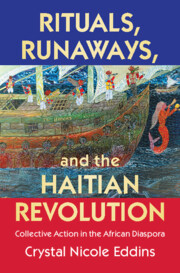Book contents
- Rituals, Runaways, and the Haitian Revolution
- Cambridge Studies on the African Diaspora
- Rituals, Runaways, and the Haitian Revolution
- Copyright page
- Dedication
- Contents
- Figures
- Tables
- Acknowledgements
- Introduction
- I Homelands, Diaspora, and Slave Society
- II Consciousness and Interaction: Cultural Expressions, Networks and Ties, Geographies and Space
- 3 “God knows what I do”: Ritual Free Spaces
- 4 Mobilizing Marronnage: Race, Collective Identity, and Solidarity
- 5 Marronnage as Reclamation
- 6 Geographies of Subversion: Maroons, Borders, and Empire
- III Collective Action and Revolution
- Conclusion
- Notes
- References
- Index
6 - Geographies of Subversion: Maroons, Borders, and Empire
from II - Consciousness and Interaction: Cultural Expressions, Networks and Ties, Geographies and Space
- Rituals, Runaways, and the Haitian Revolution
- Cambridge Studies on the African Diaspora
- Rituals, Runaways, and the Haitian Revolution
- Copyright page
- Dedication
- Contents
- Figures
- Tables
- Acknowledgements
- Introduction
- I Homelands, Diaspora, and Slave Society
- II Consciousness and Interaction: Cultural Expressions, Networks and Ties, Geographies and Space
- 3 “God knows what I do”: Ritual Free Spaces
- 4 Mobilizing Marronnage: Race, Collective Identity, and Solidarity
- 5 Marronnage as Reclamation
- 6 Geographies of Subversion: Maroons, Borders, and Empire
- III Collective Action and Revolution
- Conclusion
- Notes
- References
- Index
Summary
Colonialism and plantation slavery were primarily geographic endeavors of conquering and staking claim to land and space. Rather than focus on the transience or permanency of escape, that is to say the debates about petit and grand marronnage, this chapter argues that maroons were spatially pervasive in Saint Domingue and employed their knowledge of geographic settings and geopolitical borders to subvert locations delineated for plantation development and imperial expansion. Mountains, sinkholes, caves, and rivers provided physical pathways for maroons to secretly traverse the colony or to stake out hiding spaces. The geopolitical border dividing French Saint Domingue and Spanish Santo Domingo also represented a form of cultural knowledge that Africans in Saint Domingue exploited for well over a century by taking up arms against both empires and fleeing to Santo Domingo, seeking freedom from enslavement or better treatment and quality of life.
- Type
- Chapter
- Information
- Rituals, Runaways, and the Haitian RevolutionCollective Action in the African Diaspora, pp. 206 - 240Publisher: Cambridge University PressPrint publication year: 2021



